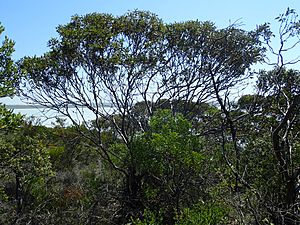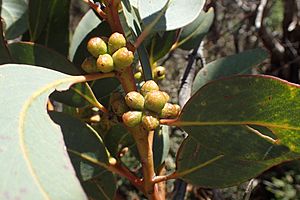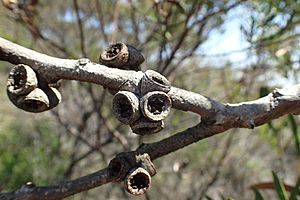Cong mallee facts for kids
Quick facts for kids Cong mallee |
|
|---|---|
 |
|
| Eucalyptus conglobata near the Pink Lake, Esperance | |
| Scientific classification | |
| Genus: |
Eucalyptus
|
| Species: |
conglobata
|
The Cong Mallee, also called Eucalyptus conglobata, is a type of eucalypt tree. It is found along the southern coast of Western Australia and South Australia. This plant is known as a mallee, which means it's a shrubby tree with many stems growing from the ground. It has smooth bark and long, narrow adult leaves. Its flowers are white, and they grow in groups of seven. The fruit are round and grow in clusters.
Contents
What Does the Cong Mallee Look Like?
The Cong Mallee is usually a mallee, which is a type of shrub or small tree. It typically grows about 5 to 8 metres (16 to 26 feet) tall. Sometimes, it can even grow into a taller tree, reaching up to 20 metres (66 feet).
Its bark is smooth and can be grey, brown, or creamy grey. Young plants and new shoots have stems that are somewhat square. Their leaves are a dull bluish-green, shaped like an egg or a wide spear. These leaves are about 55 to 115 millimetres (2.2 to 4.5 inches) long and 30 to 50 millimetres (1.2 to 2.0 inches) wide.
Adult leaves are usually a dull bluish-green and shaped like a spear. They are about 70 to 130 millimetres (2.8 to 5.1 inches) long and 15 to 40 millimetres (0.59 to 1.57 inches) wide. These leaves grow on a stalk called a petiole, which is about 10 to 25 millimetres (0.39 to 0.98 inches) long.
The flower buds grow in groups of seven. They are found where the leaves meet the stem, on a small stalk called a peduncle. This stalk is up to 7 millimetres (0.28 inches) long. Each individual bud does not have its own stalk; they are attached directly.
When the buds are ready to open, they are crowded together. They are oval-shaped and can be green or yellow. They measure about 7 to 15 millimetres (0.28 to 0.59 inches) long and 5 to 8 millimetres (0.20 to 0.31 inches) wide.
The Cong Mallee flowers from November to May, and its flowers are white. After flowering, the plant produces woody, round fruits. These fruits are crowded together and are flattened on one side.
How Was the Cong Mallee Named?
The Cong Mallee was first officially described in 1867 by a scientist named George Bentham. He used an earlier, unpublished description by Robert Brown. Brown had originally called it Eucalyptus dumosa var. conglobata. This description was published in a book called Flora Australiensis.
Later, in 1922, another scientist named Joseph Maiden decided that this plant was different enough to be its own species. So, he changed its name to Eucalyptus conglobata.
The scientific name conglobata likely refers to how the flower buds and fruits grow in tight clusters. Another subspecies of this plant is called perata. This name comes from the Latin word peratus, which means "western." This refers to where this subspecies grows compared to the main conglobata type.
There are two main types, or subspecies, of Cong Mallee. One type has fruits that are 7 to 11 millimetres (0.28 to 0.43 inches) across. The other type, called perata, has narrower leaves and smaller buds. Its fruits are only 5 to 7 millimetres (0.20 to 0.28 inches) across.
Where Does the Cong Mallee Grow?
The Cong Mallee grows in tall shrublands, which are areas with many shrubs. The main subspecies, conglobata, is the only one found in South Australia, near Port Lincoln. It is also very common in Western Australia, between Israelite Bay, Esperance, and Salmon Gums.
The subspecies perata grows mostly west of Esperance. You can find it in places like the Stirling Ranges, Fitzgerald River National Park, and Ravensthorpe. In areas where both types grow, it can be hard to tell them apart.
Is the Cong Mallee Protected?
The Western Australian Government's Department of Parks and Wildlife has classified both subspecies of Eucalyptus conglobata as "not threatened." This means they are not currently at risk of disappearing.
See also
 In Spanish: Mallee blanco para niños
In Spanish: Mallee blanco para niños



